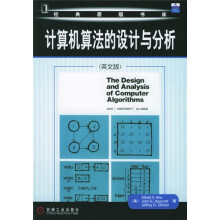计算机算法的设计与分析(英文版)
作者:(美)阿霍 等著
出版:机械工业出版社 2006.1
丛书:经典原版书库
页数:470
定价:48.00 元
ISBN-10:7111177754
ISBN-13:9787111177753
去豆瓣看看 1 Models of Computation
1.1 Algorithms and their complexity
1.2 Random access machines
1.3 Computational complexity of RAM programs
1.4 A stored program model
1.5 Abstractons of the ARM
1.6 A primitive model of computation:the Turing machine
1.7 Relationship between the Turing machine and RAM models
1.8 Pidgin ALGOL-a high-level lanuage
2 Design of Efficient Algorlthms
2.1 Data structures:lists,queues ,and stacks
2.2 Set representations
2.3 Graphs
2.4 Trees
2.5 Recursion
2.6 Divide-and -conquer
2.7 Balancing
2.8 Dynamic programming
2.9 Epilogue
3 Sorting and Order Statistics
3.1 The Sorting problem
3.2 Radix Sorting
3.3 Sorting by comparisons
3.4 Heapsort-An O Comparison sort
3.5 Quicksort-an O expected time sort
3.6 Order statistics
3.7 Expected time for order statistics
4 Data Structures for Set Manipulation Problems
4.1 Fundamental operations on sels
4.2 Hashing
4.3 Binary search
4.4 Binary search trees
4.5 Optimal binary search trees
4.6 A simple disjoint-set union algorithm
4.7 Tree Structures for the UNION-FIND problem
4.8 Applications and extensions of the UNION-FIND algorithm
4.9 Balanced tree schemes
4.10 Dictionaries and priorty queues
4.11 Mergeable heaps
4.12 Concatenable queues
4.13 Partitioning
4.14 Chapter summary
5 Algorithms on Graphs
6 Matrix Multiplication and Related Operations
7 The Fast Fourier Transform and its Applications
8 Integer and Polynomial Arithmetic
9 Pattern-Matching Algorithms
10 NP-Complete Problems
11 Some Provably Intractable Problems
12 Lower Bounds on Numbers of Arithmetic Operations
Bibllography
Indes
Alfred V.Aho于普林斯顿大学获得博士学位,现任贝尔实验室基础科学研究院副院长,计算机科学研究中心主任、ACM自动控制与可计算机理论特别兴趣组副主席以及美国国家科学基金会计算机与信息技术顾问委员会主席。
《计算机算法的设计与分析(英文版)》是一部经典著作,着重介绍了计算机算法设计领域的统一原则和基本概念。书中深入分析了一些计算机模型上的算法,介绍了一些有效算法常用的数据结构和编程技术,为读者提供了有关递归方法、分治方法和动态规划方面的详细实例和实际应用,并致力于更有效算法的设计和开发。同时,对NP完全等问题能否有效求解进行了分析,并探索了应用启发算法解决问题的途径。另外,本书还提供了大量富有指导意义的习题。
《计算机算法的设计与分析(英文版)》可以作为高等院校计算机专业本科生和研究生算法设计课程的教材,也可以作为计算机算法理论中更高级课程的教材。
比价列表








 缺书网
缺书网 扫码进群
扫码进群